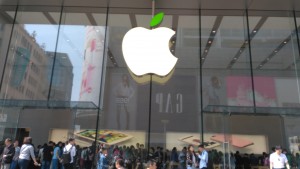SMARTPHONES: Apple Holds Firm on China iPhone Premium
Bottom line: Apple’s decision to keep iPhone 7 prices in China roughly the same as the 6s is aimed at reversing its sliding sales, but won’t have much effect due to lack of major new features and stiff competition from domestic rivals.

Despite skidding sales and early bets that its latest smartphone won’t do well in China, Apple (Nasdaq: AAPL) won’t be giving any bargains to its fans in the world’s biggest smartphone market, according to newly released global prices for the iPhone 7. The move comes as a bit of a surprise, since Apple desperately needs to reverse its recent downward plunge in China, which is now its second biggest global market after only the US. But a number of factors are at play here, including a rapidly devaluing Chinese currency and also Apple’s hesitation to lower its prices into the same realm as some of its fast-rising homegrown Chinese rivals.
China has become a particularly worrisome market for Apple in the last year, as its premium iPhones get crowded out by increasingly sophisticated and far cheaper domestically produced rival models by brands like Huawei. The company’s iPhone sales in China plunged 32 percent in the second quarter, as its share of the world’s largest smartphone market sank to 7.8 percent from 11.9 percent a year earlier. (previous post)
Against that backdrop, Apple’s pricing for its new phones is an important indicator of how it intends to position itself in a bid to reverse its sliding fortunes. CEO Tim Cook has visited the country at least twice in the last 5 months, including his last trip in August when he announced plans to build a major R&D center in China. (previous post)
There are a number of ways to look at the latest prices from Apple, so let’s begin with how the latest iPhone 7 price for China compares to the last two models, the iPhone 6 and 6s. The iPhone 7 is quite a bit more expensive than the 6 in US dollar terms for the 32 GB model, costing $805 for the former versus $693 for the latter, according to my own calculations using various new and older data. (English article; Chinese article)
But it’s also noteworthy that the iPhone 7 in China is roughly priced the same as the 6s, which was Apple’s latest new model that debuted about a year ago. That’s quite significant, since China’s currency, the yuan, has depreciated a bit over the last year due to pressures created by the country’s slowing economy.
Smaller Profits
Hence one could argue that Apple is reaping smaller profits from this latest iPhone at the newly announced prices, even though they are roughly comparable to the last model. Thus the trend looks like a slowdown or even freeze in price hikes over the shorter term, even at the expense of profits, as Apple tries to reverse its recent slide. That said, it’s also important to note that even as Apple freezes prices, this latest iPhone 7 is still well over twice as expensive as Huawei’s latest top-end model, the P9.
We can also look at the new iPhone 7 prices for China and how they compare to what’s being charged in the US, which is typically the cheapest place in the world to buy Apple products. The $805 being charged for the iPhone 7 in China is quite a bit more expensive than the US price of $647, equating to a premium of 24 percent.
But once again, it’s noteworthy that the big premium is still slightly less than the 28 percent premium for the last model, the 6s. The premium for the iPhone 6 was a more modest 16 percent, though we should point out that Apple was still one of China’s leading smartphone brands when the iPhone 6 was first released 2 years ago. China’s currency was also much stronger then.
Much has changed since then, both for China and also for Apple. The company is suffering from inability to come out with cutting edge new models with features that inspire fans to upgrade to new handsets. That was apparent in reviews for the latest iPhone, whose lack of major new features prompted market research firm IDC to predict the iPhone 7 would post a weaker debut in China than the 6s. (previous post)
At the same time, China’s crowded field of homegrown smartphone makers is rapidly catching up to the slowing Apple. Those include not only Huawei, whose phones are rapidly seen as an acceptable and far more affordable alternative to Apple, but also the fast-rising Oppo and Vivo. At the end of the day, it’s probably fair to say Apple’s decision to control its price increases for the iPhone 7 in China is part of a strategy to reverse its sliding sales. But I’m doubtful the decision will be too effective, since the iPhone premium is still quite large and the new phones lack many major compelling new features.
Related posts:
- GUEST POST: iPhone 7 Will Not Be a Huge Hit in China
- SMARTPHONES: Stumbling Apple Brings R&D Center to China
- SMARTPHONES: Huawei Hits Brakes, Apple Tumbles in Q2
- Today’s top stories
(NOT FOR REPUBLICATION)
